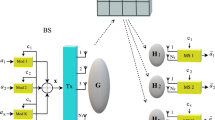Abstract
In recent years, combination of single-carrier frequency-domain equalization (SC-FDE) and space-time block coding/code (STBC) techniques to exploit the advantages of both, has received a great attention. In this paper we propose new techniques for combining SC-FDE with orthogonal and Quasi-orthogonal STBCs applicable to any number of transmit antennas. For Quasi-orthogonal STBC we first propose a new structure for codes with four transmit antennas and then extend it to higher numbers. We convert Quasi-orthogonal system to two equivalent orthogonal subsystems and equalize and decode these subsystems based on our proposed procedure for orthogonal codes. Finally, we present our simulation results for different frequency-selective wireless and power-line channels and show that a significant SNR gain is achieved when SC-FDE is combined with diversity techniques.
Similar content being viewed by others
References
Pancaldi F., Vitetta G. M., Kalbasi R., Al-Dhahir N., Uysal M., Mheidat K. (2008) Single-carrier frequency domain equalization. IEEE Signal Processing Magazine 25(5): 37–56
Falconer D., Ariyavisitakul S. L., Benyamin-Seeyar A., Eidson B. (2002) Frequency domain equalization for single-carrier broadband wireless systems. IEEE Communication Magazine 40(4): 58–66
Acolatse K., Bar-Ness Y. (2011) Single carrier frequency domain equalization space–time block-spread CDMA with multiuser interference-free detection. Springer Wireless Personal Communications 57: 481–499
Wen J. H., Chang Ch.-W., Hang H.-L. (2010) Blind multiuser detection in frequency domain for mc-cdma systems using particle swarm optimization. Springer Wireless Personal Communications 54: 447–466
Zhang, J., & Zheng, Y. R. (2012). Joint frequency-domain multiuser turbo equalization with successive interference cancellation for doubly-selective fading Channels. Springer. Wireless Personal Communications. doi:10.1007/s11277-012-0509-6.
Wang G., Yang H., Yi K. (2012) New combining scheme in STBC single carrier block transmission system. Springer Wireless Personal Communications 62: 387–394
Al-Dhahir N. (2001) Single-carrier frequency-domain equalization for space-time block-coded transmissions over frequency-selective fading channels. IEEE Communication Letter 5(7): 304–306
Sheikh-Hosseini M., Molavi-Kakhki M. (2009) Single carrier transmission in power line channels using time and frequency domain decision feedback equalizations. International Journal of Tomography Statistics 12(F09): 94–104
Ng Y. H., Chuah T. Ch. (2010) Single-carrier cyclic prefix-assisted PLC systems with frequency-domain equalization for high-data-rate transmission. IEEE Transactions on Power Delivery 25(3): 1450–1457
Biglieri E. (2003) Coding and modulation for a horrible channel. IEEE Communication Magazine 41(5): 92–98
Mheidat, H., Uysal, M., & Al-Dhahir, N. (2004). Time and frequency-domain equalization for quasi-orthogonal STBC over frequency-selective channels. In Proceedings of IEEE International Conference on Communications (ICC’04) (pp. 697–701), June 2004.
Jafarkhani H. (2001) A quasi-orthogonal space-time block code. IEEE Transactions on Communications 49: 1–4
Tirkkonen, O., Boariu, A., & Hottinen, A. (2000). Minimal nonorthogonality rate 1 space-time block code for 3Tx antennas. In Proceedings of IEEE 6th international Symposium on Spread-Spectrum Techniques and Applications (ISSSTA 2000) (pp. 429–432), Sept. 2000.
Alamouti S. (1998) A simple transmitter diversity scheme for wireless communications. IEEE Journal on Selected Areas in Communications 16(8): 1451–1458
Tarokh V., Jafarkhani H., Calderbank A. R. (1999) Space time block codes from orthogonal design. IEEE Transactions on Information Theory 45(5): 1456–1466
Tirkkonen O., Hottinen A. (2002) Square-matrix embeddable space-time block codes for complex signal constellations. IEEE Transactions on Information Theory 48(2): 384–395
Ganesan G., Stoica P. (2001) Space-time block codes: A maximum SNR approach. IEEE Transactions on Information Theory 47: 1650–1656
Su W., Xia X.-G. (2003) Two generalized complex orthogonal space-time block codes of rates 7/11 and 3/5 for 5 and 6 transmit antennas. IEEE Transactions on Information Theory 49: 313–316
Devillers B., Louveaux J., Vandendorpe L. (2008) About the diversity in cyclic prefixed single-carrier systems. Elsevier Physical Communication Journal 1(4): 266–276
Tajer A., Nosratinia A., Al-Dhahir N. (2011) Diversity analysis of symbol-by-symbol linear equalizers. IEEE Transactions on Communications 59(9): 2343–2348
COST 207. (1989). Digital land mobile radio communications: Final report. Office for Official Publications of the European Communities, Luxembourg
Babic, M., Hagenau, M., Dostert, K., & Bausch, J. (2005).D4 Theoretical postulation of PLC channel model. Tech. Rep., OPERA, March 2005.
Canova, A., Benvenuto, N., & Bisaglia, P. (2010). Receivers for MIMO-PLC channels: Throughput comparison. In Proceedings of international symposium on power line communication and its applications (pp. 114–119), March 2010.
Zimmermann M., Dostert K. (2002) Analysis and modeling of impulsivenoisein broad-band powerline communications. IEEE Transactions on Electromagnetic Compatibility EMC-44(1): 249–258
Ghosh M. (1996) Analysis of the effect of impulsive noise on multicarrier and single carrier QAM systems. IEEE Transactions on Communications 44: 145–147
Author information
Authors and Affiliations
Corresponding author
Rights and permissions
About this article
Cite this article
Sheikh-Hosseini, M., Molavi-Kakhki, M. & Hodtani, G.A. Frequency-Domain Equalization for Orthogonal and Quasi-Orthogonal STBCs over Frequency-Selective Wireless and Power-Line Channels. Wireless Pers Commun 71, 2445–2461 (2013). https://doi.org/10.1007/s11277-012-0947-1
Published:
Issue Date:
DOI: https://doi.org/10.1007/s11277-012-0947-1




